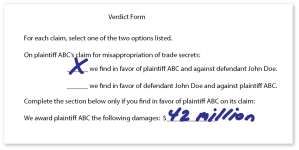Even with the Spectre of a “Good Count – Bad Count” Doctrine Reversal on Appeal, Alabama’s General Verdict Form Still Favors the Plaintiff.
Mike Skotnicki
Posted on May 22, 2014
The Alabama judicial system, pursuant to Rule 49, Ala.R.Civ.P., provides for the use of a general verdict form that does not require the jury to state on which of the count or counts it found in favor of the plaintiff. While a plaintiff’s counsel may favor use of a general verdict because it simplifies the work of the jury and obscures error that may have occurred in reaching the verdict, that benefit can become a quite a detriment to upholding the verdict on appeal.

I believe one the doctrines of Alabama jurisprudence most favored by the state appellate courts is the “good count – bad count” rule. As explained in the case of Aspinswall v. Gowens, 405 So.2d 134 (Ala. 1981), and countless more opinions, a plaintiff’s verdict will be overturned and a motion for new trial granted when a general verdict form is used and the appellate court determines both a “good count” a “bad count” was submitted to the jury. The new trial is required because it cannot be presumed, given the possibilities provided by use of a general verdict form, that the jury found for the plaintiff on the count determined by the appellate court to be a good count. I used the doctrine to my advantage years ago in successfully overturning on appeal a $500,000 jury verdict in Delta Health Group, Inc. v. Stafford, 887 So.2d 887 (Ala. 2004), a case that later settled.
In addition to the natural reasons why the good count – bad count doctrine would be used by the court, I believe application of this doctrine is favored because it allows an appellate court to reach a compromise on the appeal. An opinion based on the doctrine overturns the verdict and likely a large damages award that can put political pressure on the elected justices to reverse, yet ensures the plaintiff has another opportunity for a trial on a “good count” with the benefit of using the first trial as a road map. More often than not, it puts the case in a posture ripe for settlement for a sum less than that awarded by the jury yet undoubtedly much more than the defendant had previously offered.
Thus, use of the good count – bad count rule allows the appellate court to give both sides get a “win.” The defendant’s counsel successfully overturned the verdict on appeal and gets credit for doing so from his or her client. Although the plaintiff’s trial win is overturned, the plaintiff and counsel still may see a victory in the near term. Thus, the general verdict form remains one of the best things that plaintiffs have going for them in the Alabama judicial system.
Tagged: Alabama Supreme Court, Appeal, Bad Count, General Verdict, Good Count, Trial court